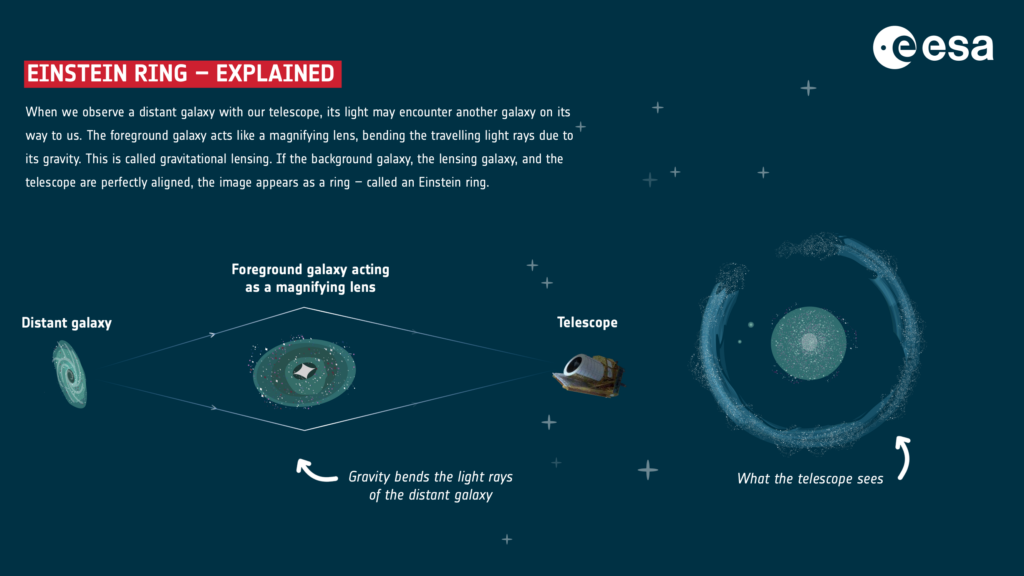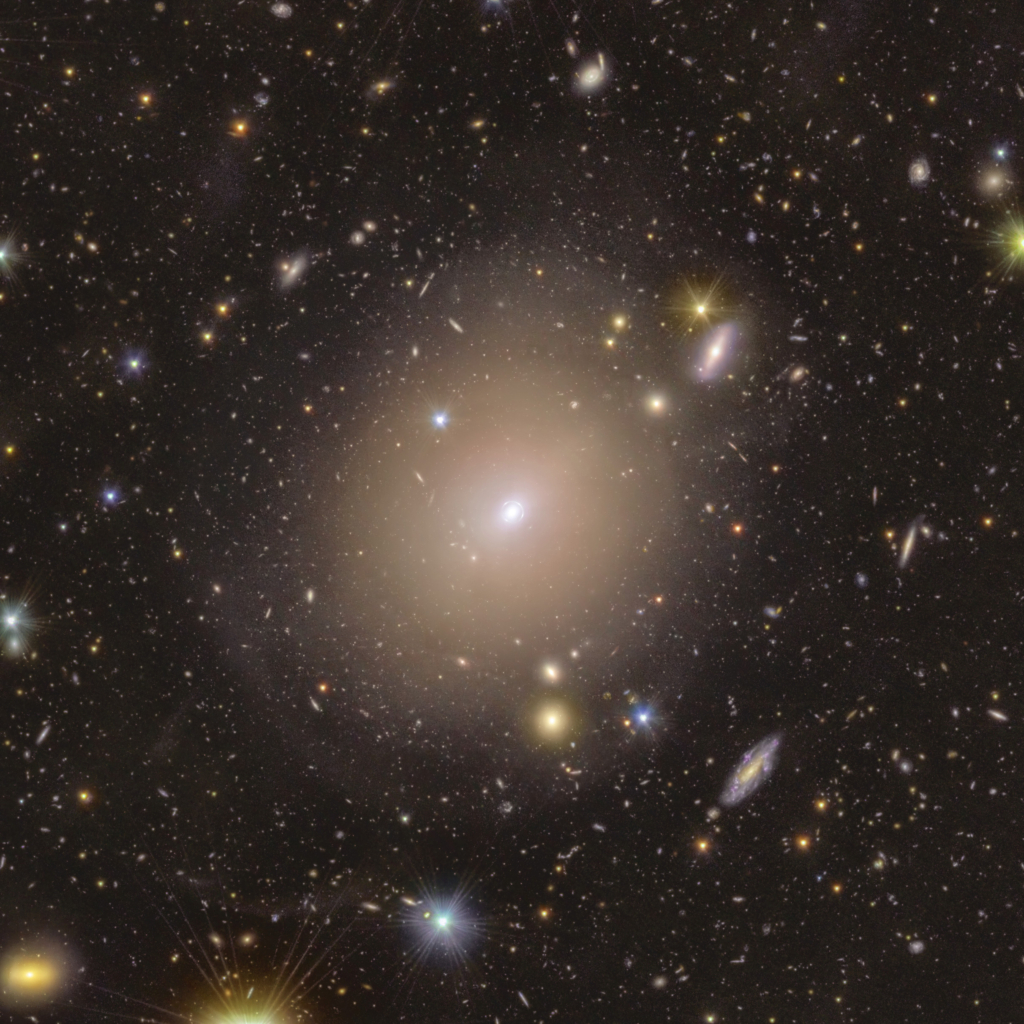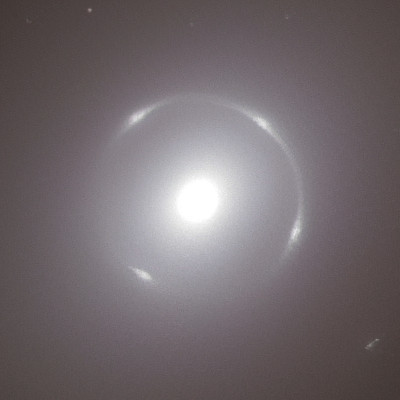Gravitational lenses are rare in the sky – galaxies bending the light-paths of light from other galaxies behind them to form distorted or even multiple images. Even rarer is a perfect alignment of the two galaxies with us, the obervers, with the light being bent into a so-called Einstein Ring. And the rarest case was now observed by Euclid: this happening in an extremely nearby NGC galaxy.
Gravitational lensing is the effect of mass bending space and light following along this bent space. If the masses are high enough, as for a galaxy, then this can lead to an image of an object behind a galaxy to be distorted or even split up into several images: a strong gravitational lens. If vary rare cases – for a perfect alignment of source, galaxy, and observer on a line – the image gets bent into a ring. These so-called Einstein Rings have been found before, but in all configurations only approximately 1000 gravitational galaxy–galaxy lenses are currently known across the sky.

The phenomenon of strong gravitational lensing has been first discussed already in the late 1700s, in the case of Newtonian gravity. But only Albert Einstein was able to calculate the correct angle of light-bending, using his General Theory of Relativity in 1915. In the years after, expeditions to properly measure the lensing effect for the mass of the sun during a solar eclipse then actually confirmed General Relativity based on the lensing effect. This was for the sun.
Coming back much more massive galaxies, the realisation that they could act as lenses – and image sources in the background – took until 1937 when Fritz Zwicky used the new knowledge about galaxies being really distant collections of stars like our own Milky Way. And in the 1960s it was realized that quasars, very bright, point-like active centers of galaxies, would make the perfect sources for lensing. And so it took until 1979, when the first “twin” quasar was found and identified as two images of the same background source – the first observed gravitational lens.
To dive deeper, the chance of a galaxy – or galaxy cluster – acting as a gravitational lens is highest for some intermediate distance from us observers, and for the source galaxy to be quite a bit further away. Most gravitational lens galaxies are therefore several billions of light-years away. So it’s extremely rare for lensing galaxies to be very close to us. A galaxy has to be very massive to have enough impact to create multiple lensed images, so what we would call “in our neighbourhood”, within a distance of 700 million light years, only 2400 galaxies exist that would be massive enough. Then, given the background distribution of available sources, of these nearby galaxies only 1 in 2000 has a statistical chance of actually creating a bright lensed system, with an increasing chance for fainter and fainter sources being lensed.

Euclid colour image of the full NGC 6505, composited using data from Euclid’s VIS high-resolution imager (structure), and the NISP near-infrared instrument (colours). The Einstein Ring is visible in around the very center of the galaxy. Credit: ESA/Euclid/Euclid Consortium/NASA, image processing by J.-C. Cuillandre, T. Li
(Click to enlarge)
So when ESA and Euclid Consortium scientists looked through the first science data, it did not come as a surprise that they spotted a first first gravitational lens – overall Euclid is expected to 100-fold the number of known lenses and find 100,000 during its 6-year mission. However it is beyond astonishing that the first lens is very nearby, actually located in an NGC galaxy – from the New General Catalogue of nearby galaxies – and that it shows a perfect Einstein Ring of the source galaxy. The lens galaxy is NGC 6505, located at redshift z=0.042, corresponding to a distance of only 590 million light-years. Only five similarly nearby other gravitational lenses are known so far, but none in such a prominent galaxy. NGC 6505 has been known since the year 1884, but no-one up to now was able to take an image as clear as Euclid has done. Follow-up spectroscopy with the Keck telescope on Hawaii and its KCWI integral-field spectrograph showed the source galaxy to lie at redshift z=0.406, or about 4.5 billion light-years distance from us.
While the image of NGC 6505 itself is already stunning, with many other galaxies around it and thousand’s more in the background, the surprise came with the first look into its very center: Is that a ring? And why did it look so peculiar? Galaxies can in fact have rings of stars near their centers that can form from motions of gas and stars – but normally only for rotating spiral galaxies, when at a certain distance from the center no net forces exist to move material further in or out. But this is not expected for a spheroidal galaxy as NGC 6505. With the peculiar structure of the right it was quickly clear that this must be the case of strong gravitational lensing, and the ring was actually not part of NGC 6505 but the distorted image of a background galaxy. A more close inspection and modelling extracted an almost too-good-to-be true Einstein Ring.

The lensed image of the background galaxy, in the very center of NGC 6505, as seen by Euclid’s VIS instrument. The background of NGC 6505’s light has been suppressed for clarity. The ring is made up of the stretched image of the background source galaxy. The bright center is the center of NGC 6505 itself. Credit: ESA/Euclid/Euclid Consortium/NASA, image processing by J.-C. Cuillandre, T. Li
But this is understandable: never before has an Einstein Ring be found in an NGC galaxy, and never has such an exquisite telescope looked at this galaxy so long. Euclid visited NGC 6505 and the region around it in its initial “Performance Verification” phase in late 2023. Euclid observed this region multiple times, with a total integration time of more than 11 hours with VIS and almost 2 hours with NISP, about 50x longer than most fields in Euclid ongoing Wide Survey. So this image and the whole field have an exceptional signal, low noise, and this allowed an unprecendented modelling of the lens system.
The science analysis was able to extract information about the amount of dark matter in the center of NGC 6505 (11.1% of the total central mass), as well as make very precise statements about the composition of low- and high-mass stars in the central region. Simulation show that the chance for finding a lens at this distance with the brighness that is seen in NGC 6505 was computed 1 in 2000 – and between 4 and 20 further nearby lenses are predicted to still be found in Euclid’s Wide Survey over the next years. However, the fact that this lens in NGC 6505 indeed exists and was observed by Euclid and recognised so quickly, was sheer coincidence – and attention to the data.
More lenses at larger distances are currently being searched for and first results for Euclid’s Q1 Data Release will be presented on the 19th of March 2025.
Further reading:
- Press release by ESA on the NGC 6505 lens and full-resolution images
- Original paper: “Euclid: A complete Einstein ring in NGC 6500”, O’Riordan et al. (2025), published by Astronomy & Astrophysics, https://www.aanda.org/10.1051/0004-6361/202453014


